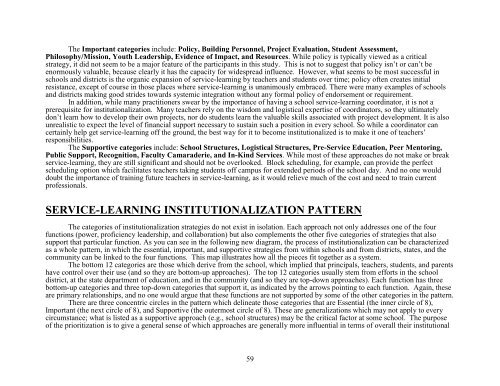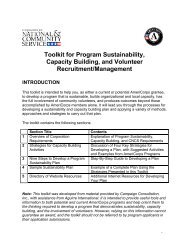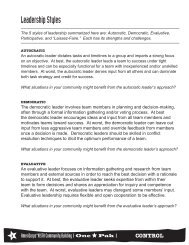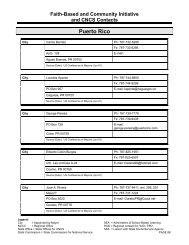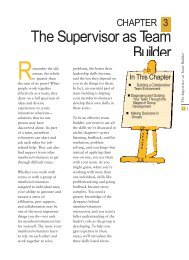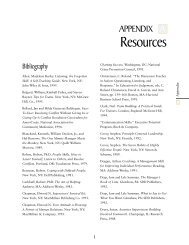MAKE IT LAST FOREVER: THE ... - National Service Resource Center
MAKE IT LAST FOREVER: THE ... - National Service Resource Center
MAKE IT LAST FOREVER: THE ... - National Service Resource Center
Create successful ePaper yourself
Turn your PDF publications into a flip-book with our unique Google optimized e-Paper software.
The Important categories include: Policy, Building Personnel, Project Evaluation, Student Assessment,<br />
Philosophy/Mission, Youth Leadership, Evidence of Impact, and <strong>Resource</strong>s. While policy is typically viewed as a critical<br />
strategy, it did not seem to be a major feature of the participants in this study. This is not to suggest that policy isn’t or can’t be<br />
enormously valuable, because clearly it has the capacity for widespread influence. However, what seems to be most successful in<br />
schools and districts is the organic expansion of service-learning by teachers and students over time; policy often creates initial<br />
resistance, except of course in those places where service-learning is unanimously embraced. There were many examples of schools<br />
and districts making good strides towards systemic integration without any formal policy of endorsement or requirement.<br />
In addition, while many practitioners swear by the importance of having a school service-learning coordinator, it is not a<br />
prerequisite for institutionalization. Many teachers rely on the wisdom and logistical expertise of coordinators, so they ultimately<br />
don’t learn how to develop their own projects, nor do students learn the valuable skills associated with project development. It is also<br />
unrealistic to expect the level of financial support necessary to sustain such a position in every school. So while a coordinator can<br />
certainly help get service-learning off the ground, the best way for it to become institutionalized is to make it one of teachers’<br />
responsibilities.<br />
The Supportive categories include: School Structures, Logistical Structures, Pre-<strong>Service</strong> Education, Peer Mentoring,<br />
Public Support, Recognition, Faculty Camaraderie, and In-Kind <strong>Service</strong>s. While most of these approaches do not make or break<br />
service-learning, they are still significant and should not be overlooked. Block scheduling, for example, can provide the perfect<br />
scheduling option which facilitates teachers taking students off campus for extended periods of the school day. And no one would<br />
doubt the importance of training future teachers in service-learning, as it would relieve much of the cost and need to train current<br />
professionals.<br />
SERVICE-LEARNING INST<strong>IT</strong>UTIONALIZATION PATTERN<br />
The categories of institutionalization strategies do not exist in isolation. Each approach not only addresses one of the four<br />
functions (power, proficiency leadership, and collaboration) but also complements the other five categories of strategies that also<br />
support that particular function. As you can see in the following new diagram, the process of institutionalization can be characterized<br />
as a whole pattern, in which the essential, important, and supportive strategies from within schools and from districts, states, and the<br />
community can be linked to the four functions. This map illustrates how all the pieces fit together as a system.<br />
The bottom 12 categories are those which derive from the school, which implied that principals, teachers, students, and parents<br />
have control over their use (and so they are bottom-up approaches). The top 12 categories usually stem from efforts in the school<br />
district, at the state department of education, and in the community (and so they are top-down approaches). Each function has three<br />
bottom-up categories and three top-down categories that support it, as indicated by the arrows pointing to each function. Again, these<br />
are primary relationships, and no one would argue that these functions are not supported by some of the other categories in the pattern.<br />
There are three concentric circles in the pattern which delineate those categories that are Essential (the inner circle of 8),<br />
Important (the next circle of 8), and Supportive (the outermost circle of 8). These are generalizations which may not apply to every<br />
circumstance; what is listed as a supportive approach (e.g., school structures) may be the critical factor at some school. The purpose<br />
of the prioritization is to give a general sense of which approaches are generally more influential in terms of overall their institutional<br />
59


